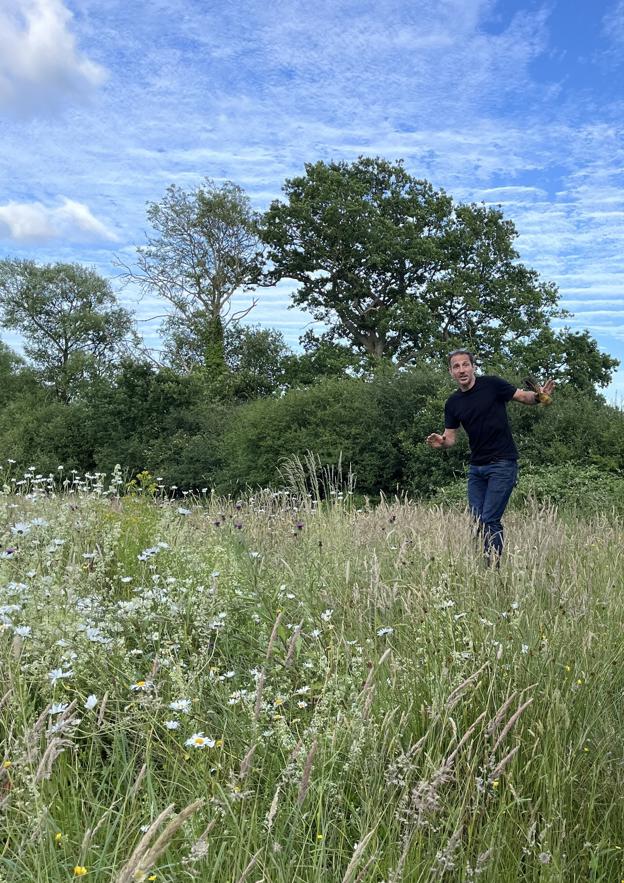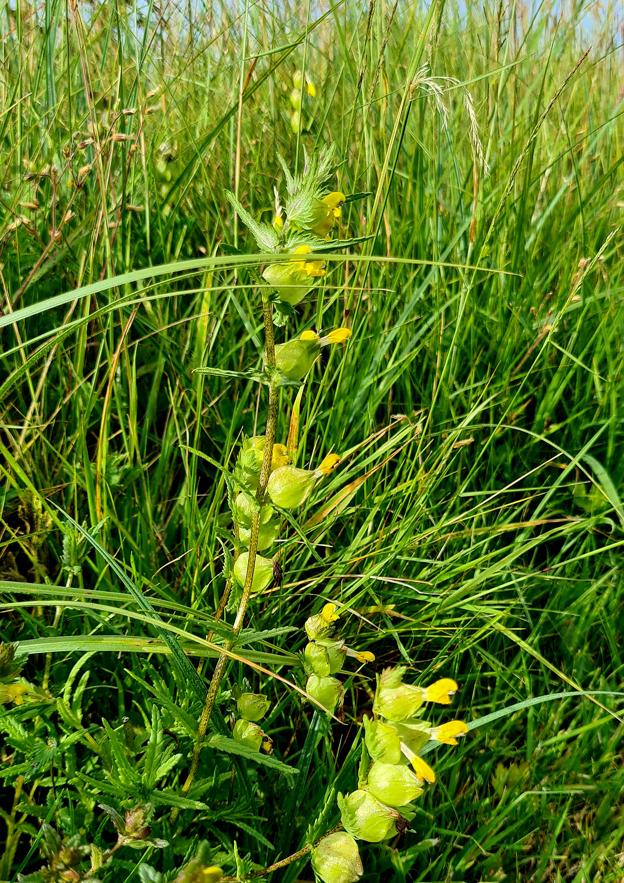Allowing what was agricultural pasture to gradually re-nature itself is a slow process requiring plenty of patience and resisting the urge to 'help it on its way'.
Within a two-acre pasture, Tom Morris and Ellie Robinson are allowing nature to reappear at its own pace, with only occasional interventions. "This is not rewilding", says Tom, "there is a bit of human management involved".
Their aim is to achieve a diverse 'litter meadow', a term that has fallen out of use, but which applies to extensive, unfertilised grasslands used for low-intensity grazing and/or hay, where the sward is cut just once per year. This type of meadow is rich in wild flowers, insects and mammals.

On a warm evening on 27 June 2024, a small group of local residents and PeCAN volunteers visited an unusual landscape on the edge of Petersfield.
Tom has employed litter-meadow and wet-meadow styles of management in the field next to his home, used various grass weakening strategies, mosaic creation and gardening-like curation, herbivore-like disturbance, nutrient removal, and no inputs. He says, "This is not an example of the mass-sowing of off-the-shelf meadow mixes, more what happens when you give nature the opportunity to return itself”.
Native flower and grass species either blow in or have emerged from the seedbank contained in the soil. When Tom and Ellie began their project in 2017 there were just five species of plant present. Now, in the meadow's seventh year, they have counted over fifty species. Key to this success is the cutting and removal of the arisings, or hay, in September, a job that can take Tom a whole week to complete. Some of the field is cut using a power-scythe, but lumpy areas that now contain molehills and anthills must be hand-scythed, and then the hay must be raked up and taken off site. It is an arduous job.
"When we first had the field we literally knocked it back for two years, mowing regularly and removing the arisings. This helps to weaken the more vigorous grasses like cocksfoot and Yorkshire fog", says Tom, "We do have a problem with nutrients on part of the site, from an old leaky septic tank, but this is being removed".

Other interventions include a small amount of experimental meadow seeding that was done some years ago, and planting six new trees. Saplings from a majestic oak, believed to be almost 400 years old, are allowed to remain; the pair have resisted the temptation to intervene, even when relatively unpopular ragwort colonised the bare soil exposed by moles and ants. They wish to let each species find its own place, kept in check only by competition with other species, grazing by wild animals and their annual meadow-cut.
The site is close to the Heath and shares its geology with a greensand ridge descending to tertiary clay towards the Criddle stream. Parts of the site dries out and parts remain damp or even water-logged, giving rise to a variety of conditions for wildlife.
Ellie welcomes the moles, roe-deer, ants and mice, describing them as habitat engineers, as they help to disperse seed and create new niches. "There were no anthills seven years ago, and now meadow ants and red ants are providing habitat for solitary bees through their excavation of the sand".
Many species now use this site for breeding and foraging, from owls, foxes and roe deer, to pygmy shrews and woodmice. The twelve native grass species provide important habitat for a huge range of insects, from moths to craneflies and crickets, including Roesel's cricket.
Of the wild flowers, new arrivals include common fleabane, three species of St.John's wort, mignonette and hedge bedstraw. Common spotted orchid has appeared and at least three species of willow-herb are present, as is all-important birds-foot trefoil. Three rush species: slender-, heath- and soft-rush, occupy damp patches.
Hayrattle (or yellow rattle) was seeded after the first few cuts a few years ago. This annual plant self-seeds and it plays an important part in a meadow as a hemi-parasite, by reducing the vigour of grasses so allowing more wild flowers to establish. A few piles of cut grass are left for the benefit of snakes and slow worms, perches are being put in for owls and flycatchers, and occasional sheets of corrugated iron attract toads and insects.
Tom and Ellie are keen to share their experience with others who might also have an opportunity to re-nature a piece of land. Tom says, " I must stress I'm an amateur learning as we go along. I would love to hear from others embarking on a similar project. We could compare notes".
If you are considering a similar project please contact Tom via email - [email protected]
